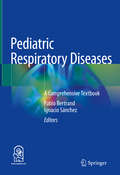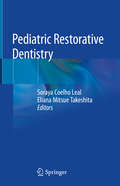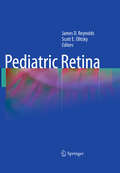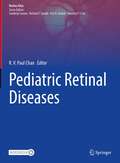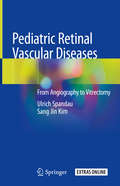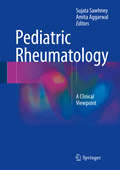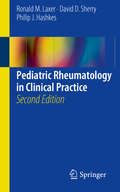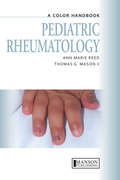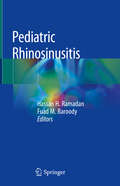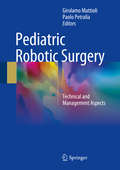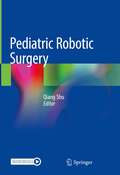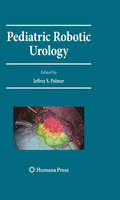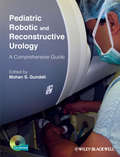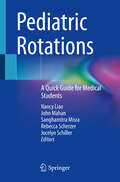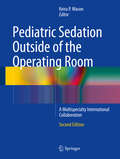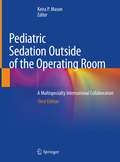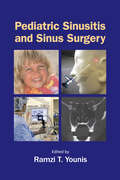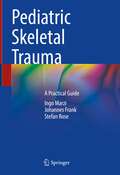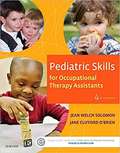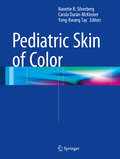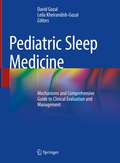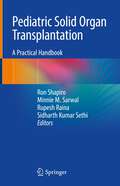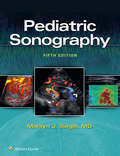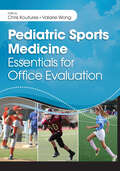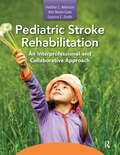- Table View
- List View
Pediatric Respiratory Diseases: A Comprehensive Textbook
by Pablo Bertrand Ignacio SánchezThis is a comprehensive and authoritative textbook on pediatric pulmonology. Edited by Pablo Bertrand and Ignacio Sánchez, renowned academics and pediatricians from the Pontifical Catholic University of Chile, it encompasses five sections and 74 chapters, presenting and discussing the most important topics related to pediatric respiratory diseases. Written and presented in a simple and didactic format, it intends to ease learning and settlement of doubts in pediatric respiratory diseases. The reader is naturally introduced into the physiology, diagnosis, syndromes, diseases and the treatment associated with the respiratory pathologies affecting children. The chapters include algorithms for the treatment of various syndromes and updated treatment proposals grounded in evidence-based medicine for more than 50 pulmonary diseases. Pediatric Respiratory Diseases – A Comprehensive Textbook is an essential reference for the proper clinical approach to respiratory diseases in children. It is intended for all interns, residents and fellows with interest in pediatric pulmonary medicine, as well as practicing physicians, general practitioners, pediatricians and pulmonologists who face pediatric respiratory disorders in daily clinical practice.
Pediatric Restorative Dentistry
by Soraya Coelho Leal Eliana Mitsue TakeshitaThis book describes and discusses the different restorative options for managing carious lesions in children with primary and mixed dentition. The aim is to provide practitioners with thorough, up-to-date information that will improve their clinical practice. The opening chapters present a comprehensive overview regarding diagnosis of carious lesions, risk assessment, child behavior and development, and behavioral management. The importance of oral health promotion and prevention in controlling lesion progression and maintaining oral health is reviewed. The impact of various factors on clinician decision making is then explained in detail, examples including the type of dentition (primary versus permanent), the clinical and radiographic aspect of the dentine carious lesion (noncavitated or cavitated), and whether the lesion is associated with a developmental defect. Guidance is provided on selection of nonoperative versus operative interventions, and the restorative materials most frequently used in pediatric dentistry are fully described, highlighting their advantages and disadvantages. Readers will also find an informative series of cases, with explanation of the choices in terms of materials and approach.
Pediatric Retina
by James D. Reynolds Scott E. OlitskyPediatric retinal diseases are not simply retinal diseases that occur in children; rather, they are unique disorders that often are not found in adults. This textbook of the pediatric retina offers in-depth guidance on congenital and acquired diseases of the retina in the pediatric population. It is organized according to disease onset and timing, as well as anatomy. All chapters are written by leading authorities in the field from both the pediatric and the retinal perspective. A multidisciplinary approach to the topic is adopted, and critical information is included on disease classification and diagnosis, pathophysiology, genetics, complications, and prognosis. Pediatric Retina will be a useful source of information for pediatric ophthalmologists, retina specialists, and other eye care providers who care for children.
Pediatric Retinal Diseases (Retina Atlas)
by R. V. Paul ChanThis volume on pediatric retina covers all aspects of pediatric retinal diseases as their understanding, diagnosis and management is still under evolution and a challenging task. Newer diagnostic and surgical techniques are being developed and are being adapted for better visual outcome in pediatric cases. It comprises of 10 chapters describing the medical and surgical aspects. The text and figures have been provided in a lucid manner to enhance the understanding of the reader. This volume covers OCT angiography for pediatric retinal disease, clinical spectrum of retinopathy of prematurity, which has become an ever increasing burden of disease for the society and needs special attention, anti-VEGF for retinopathy of prematurity, surgical management of retinopathy of prematurity, retinopathy of prematurity: atypical aspects, Coats’ disease, pediatric retinal inflammatory disorders, congenital X-linked retinoschisis, familial exudative vitreoretinopathy, hematologic disorders: leukemia, hyperviscosity, anemia. It provides descriptions of these disease accompanied by numerous helpful images to highlight these conditions. This atlas will assist the vitreoretinal specialists, general ophthalmologists, retina fellows and post graduate students in successfully identifying the key features of these challenging pediatric vitreoretinopathies. Pediatric Retinal Diseases is one of the nine volumes of the series Retina Atlas. This series provides global perspective on vitreoretinal diseases, covering imaging basics, retinal vascular disease, ocular inflammatory disease, retinal degeneration, surgical retina, ocular oncology, pediatric retina and trauma. Retina Atlas is spread over 9 volumes and about 100 chapters, covering validated and comprehensive information on retinal disorders.
Pediatric Retinal Vascular Diseases: From Angiography to Vitrectomy
by Ulrich Spandau Sang Jin KimThis book provides comprehensive and up-to-date information on diagnosis, medical and surgical treatments for pediatric retinal vascular conditions, which are leading causes of childhood blindness throughout the world. Experienced ophthalmologists in the field discuss basic knowledge about these diseases and practical aspects of management such as exam under anesthesia, diagnostic approaches including spectral-domain hand-held optical coherence tomography (OCT) and OCT angiography. The reader will learn about the recent advances in medical and surgical treatments for pediatric retinal vascular diseases. The surgical treatments, anti-VEGF injections, laser photocoagulation and lens sparing vitrectomy are explained step-by-step and can be observed in several videos.Both the general ophthalmologist who cares for children with retinal diseases and the specialist (pediatric ophthalmologists and vitreoretinal surgeon) will find this book to be an informative resource in providing best care for children with pediatric retinal vascular conditions.
Pediatric Rheumatology
by Sujata Sawhney Amita AggarwalThis book on rheumatology in children is intended to be a handy tool for all professionals interested in this field. It is divided into five sections: General considerations, arthritic problems, connective tissue diseases, systemic vasculitides and finally a section that covers miscellaneous issues such as Immunodeficiencies, bone heath and uveitis. The book has an easy format with each chapter having one or more clinicalvignettes at the start of the chapter. In addition each chapter outlines the learning objectives and key take home messages. At the end of each section a collection of cases to highlight important issues in the clinic are included. The colorful charts, pictures and tables make reading this book an easy task. The authors are leading experts in their fields working at best practices centers globally to provide the reader with state-of-the-art information.
Pediatric Rheumatology in Clinical Practice
by Ronald M. Laxer David D. Sherry Philip J. HashkesThis second edition is primarily for trainees and junior pediatric residents in adult rheumatology who will be seeing pediatric patients with rheumatic diseases. The short chapters have clear tables and many clinical photos to demonstrate key features of diseases and allow the reader to be well informed when seeing patients with rheumatic diseases. This book also allows the readers to develop and approach the field and develop differential diagnoses.
Pediatric Rheumatology: A Color Handbook (Medical Color Handbook Ser.)
by Thomas Mason Anne Marie ReedPhysicians caring for children with rheumatic disease need a varied and highly developed set of clinical skills, including general pediatrics, immunology, musculoskeletal medicine and the management of chronic diseases.With these requirements in mind, the authors of this concise handbook emphasize the most frequently recognized symptom complexes in
Pediatric Rhinosinusitis
by Hassan H. Ramadan Fuad M. BaroodyThe volume provides a comprehensive, up-to-date and exhaustive review of pediatric rhinosinusitis for clinicians, surgeons, researchers, advanced care providers as well as emergency personnel. It provides information regarding pathophysiology of sinusitis, and how to distinguish between the differential diagnoses of a child with a runny nose. It also utilizes current evidence-based guidelines and consensus statements to clarify this condition to the physician and discusses available medical and surgical treatment. Authored by clinicians with long-time expertise with this disease, Pediatric Rhinosinusitis also reviews definitions, burden of disease, microbiology and pathophysiology of the disease; role of adenoids, allergy and asthma as co-morbid conditions; comprehensive medical management; and the role of topical treatment. It also covers the latest advancements in new treatments such as drug-eluting stents; comprehensive surgical management; and complications of rhinosinusitis. It will be a valuable resource for otolaryngologists, surgeons, residents, medical students and advanced practice providers for years to come.
Pediatric Robotic Surgery
by Girolamo Mattioli Paolo PetraliaThis book presents the state of the art across the entire field of pediatric robotic surgery, including thoracic, abdominal, oncologic, gynecologic, and urologic procedures. Indications for each type of robotic surgery are clearly set out and technical aspects are described in detail, illustrating the patient's position and explaining the robotic assessment and the optimal use of robotic instruments. Anesthetic issues and the management of robotic complications are discussed, and managerial aspects are also considered, with provision of helpful suggestions on how to approach robotic surgery in each pediatric department. For surgeons who wish to start using the pediatric robotic approach, simple illustrations of robotic assessment and principles of robotic surgery are included. Pediatric robotic surgery has undergone significant development in recent years, and the technology is now applied to a variety of pediatric diseases beyond urology. This book has been written by a group of world-renowned pioneers of pediatric robotic surgery and will appeal to pediatric surgeons of all disciplines, to residents, and to hospital general managers and medical directors.
Pediatric Robotic Surgery
by Qiang ShuPaediatric robotic surgery has been rapidly developed in recent years. This book presents comprehensive and advanced knowledge of different types of paediatric robotic surgery including thoracic, oncologic, abdominal and urologic surgeries. Each chapter is with the same layout as the introduction, indications and contraindications, preoperative preparation, detailed surgical approaches, and post-operative complication management as well as comparison with conventional surgery together with case presentations and video recordings in the end. It is a key reference book for paediatric surgeons and residents who would like to learn and to perform paediatric robotic surgery, and also for hospital general managers for how to establish paediatric robotic surgery settings.
Pediatric Robotic Urology
by Jeffrey S. PalmerRobotic technology has paved the way for new opportunities in pediatric urologic surgery. Where once laparoscopy was restricted to urological conditions in children such as undescended testicles and ambiguous genitalia, robotic techniques are now enabling the completion of greatly needed, more involved procedures. Written by highly respected surgeons, Pediatric Robotic Urology provides a state-of-the-art, comprehensive overview of the precise surgical techniques that are changing the practice of pediatric urologic surgery. Divided in two sections and covering both introductory topics and advanced surgical techniques, Pediatric Robotic Urology also includes myriad illustrations and photographs of intraoperative procedures. Developed for accessible reading, this invaluable title is a concise, yet broad reference that is certain to be of significant value to urologists, surgeons, and all health care providers who care for pediatric urologic patients.
Pediatric Robotic and Reconstructive Urology
by Mohan S. GundetiThe most exciting contemporary developments in pediatric urology are now demonstrated in text and on video in this innovative, practical guide. A practical text for experienced practitioners and trainees alike, this comprehensive resource introduces the new techniques and surgical planning required to begin mastery of robotic approaches. From a renowned editor and contributors, this book features 130 illustrations and comes with a companion website containing 30 high-quality surgical videos demonstrating each technique.
Pediatric Rotations: A Quick Guide for Medical Students
by Sanghamitra Misra Nancy Liao John Mahan Rebecca Scherzer Jocelyn SchillerPediatric rotations are a crucial part of medical education, yet didactic curricula often do not spend much time on pediatric-specific skills. Learners often enter the pediatric clinical setting with little preparation and orientation. The care of children is nuanced and specialized and requires a different approach than adult medicine. This text serves as a valuable resource for students on pediatric clinical rotations and for advanced practitioners entering pediatric clinical practice without much prior experience. This high yield book covers the fundamental knowledge and skills required for pediatric care, including the physical, emotional, and social development of children, and the diagnosis and management of common pediatric conditions, with emphasizes on a patient-centered approach. Clinical pearls and application exercises embedded within each chapter help students prepare for real-life clinical scenarios and written examinations. The section on communication with the medical team reviews how to present pediatric patients on family-centered rounds, how to write succinct and useful notes, how to eloquently request a consult, and safely handoff a patient. The book also features practical tips on inter-professional communication, breaking bad news, and strategies to enhance learning and achieve success while working within a pediatric care team. Finally, a portion of the book is devoted to the considerations specific to the clinical settings where most learners rotate. Written by experts in the field, Pediatric Rotations provides a detailed overview of skills required to be successful on pediatric wards and in pediatric clinics while also including the most up to date scientific and clinical information.
Pediatric Sedation Outside of the Operating Room
by Keira P. MasonThis comprehensive guide provides tips and instruction for the entire range of specialists that utilize pediatric sedation. Each specialty receives tailored coverage that focuses on its unique patient population, challenges, potential solutions, and sedation techniques. Each chapter is written by a leading specialist in the field. A comprehensive spectrum of pediatric sedation will be covered, which will be of interest to oncologists, pediatricians, hospitalists, intensivists, radiologists, emergency medicine specialists, anesthesiologists, nurses, dentists, and gastroenterologists. Background chapters cover pharmacology as well as pediatric anatomy, with special focus on the airway and respiratory mechanics. The future of pediatric sedation is also reviewed as well as the cutting-edge research that is being done in the field.
Pediatric Sedation Outside of the Operating Room: A Multispecialty International Collaboration
by Keira P. MasonThis book functions as an essential guide to the safe and effective sedation of pediatric patients outside the operating room. It is a multidisciplinary reference that features an international authorship and is also of use for a broad range of specialists who deliver pediatric sedation in the non-OR setting.Organized into four parts, Pediatric Sedation Outside of the Operating Room 3rd edition, begins with the foundational history of the pediatric sedation field. Subsequent chapters explore the basics of procedural sedation, pre-sedation assessments, and sedation policies across various specialties and continents. Part two then examines a multitude of sedation models divided by geographical location and subspecialty. Following this, Part three delves into standards of safety in sedation, including medicolegal risk factors, neurocognitive side effects, and aspiration risks. The book closes with chapters presenting discussions on the future of sedation, insofar as predictions for the role of simulation, medical malpractice, and the intersection of sedation and marijuana.An updated invaluable successor edition, Pediatric Sedation Outside of the Operating Room 3rd edition is accessible to a diverse group of sedation providers from all specialties. This textbook is an invaluable and necessary addition to all sedation providers worldwide.
Pediatric Sinusitis and Sinus Surgery
by Ramzi T. YounisComprehensively addressing the various aspects of sinus disease in children, this reference describes the entire spectrum of pediatric sinusitis management, surgery, and control-opening with sections on anatomy and pathophysiology; demonstrating approaches in diagnostic work-up and medical therapy; detailing surgical management; and considering top
Pediatric Skeletal Trauma: A Practical Guide
by Ingo Marzi Johannes Frank Stefan RoseThis book provides all the knowledge needed to treat injuries to the pediatric extremities, spine, and pelvis. It aims to enable age-appropriate diagnosis and optimal treatment selection, with particular consideration of the current developmental age of an injured child. A general overview section presents the features of skeletal growth, growth plate fusion, and the concept of non-growth-damaging treatment of pediatric fractures. The well-structured specialized chapters detail the characteristics of individual injuries with corresponding case studies. Thus, the book offers a learning opportunity but can also be used as a practical daily reference to facilitate orientation. Three chapters focus on options for the correction of injuries that have healed poorly. The book offers exceptional value through:- Classifications of fractures and injuries Schematic drawings of typical fractures with developmental characteristics Structured overview tables for all regions of injury with representation of the fracture types and their characteristic radiographsPresentation of conservative and operative treatment options and illustration of all typical situations
Pediatric Skills for Occupational Therapy Assistants
by Jane Clifford O'Brien Jean W. SolomonLearn to provide effective therapy for children and adolescents with Pediatric Skills for Occupational Therapy Assistants, 4th Edition. This market-leading text offers a comprehensive, application-focused guide to pediatric occupational therapy assisting by incorporating the AOTA Practice Framework. The text’s focused and easy-to-use approach to pediatrics covers everything from the scope of practice to in-depth coverage of normal development, pediatric health conditions, and treatment planning. This new edition has also been thoroughly updated and expanded to include new content and chapters on community systems, physical agent modalities, the Model of Human Occupation assessments, childhood obesity, documentation, neurodevelopmental treatment, and concepts of elongation.
Pediatric Skin of Color
by Nanette B. Silverberg Carola Durán-Mckinster Yong-Kwang TayPediatric Skin of Color is the first textbook devoted to the issues of pediatric skin of color. In 2052, more than fifty percent of the United States will be of color, and currently seventy percent of the world's population is termed of color. Therefore, this book fills the need for an instructional and educational referebce work regarding these populations. Pediatric Skin of Color discusses the biology and clinical data regarding normal skin, skin conditions exclusive to individuals of color, systemic diseases of individuals of color that have a strong component of skin involvement, and the appearance and demographics of common skin diseases, comparing Caucasian and all skin of color populations. Written for dermatologists and pediatric dermatologists, this text includes data on African American, Asian (Southeast and East), Hispanic/Latino, and Middle Eastern patients, as well as Indigenous populations (i. e. Native Americans, Aborigines).
Pediatric Sleep Medicine: Mechanisms and Comprehensive Guide to Clinical Evaluation and Management
by David Gozal Leila Kheirandish-GozalThis book provides comprehensive coverage of all aspects related to pediatric sleep and its associated disorders. It addresses the ontogeny and maturational aspects of physiological sleep and circadian rhythms, as well as the effects of sleep on the various organ systems as a function of development. Organized into nine sections, the book begins with a basic introduction to sleep, and proceeds into an extensive coverage of normative sleep and functional homeostasis. Part three then concisely examines the humoral and developmental aspects of sleep, namely the emerging role of metabolic tissue and the intestinal microbiota in regulation. Parts four, five, and six discuss diagnoses methods, techniques in sleep measurement, and specific aspects of pharmacotherapy and ventilator support for the pediatric patient. Various sleep disorders are explored in part seven, followed by an in-depth analysis of obstructive sleep apnea in part eight. The book concludes with discussions on the presence of sleep issues in other disorders such as Down syndrome, obesity, cystic fibrosis, and asthma. Written by recognized leaders in the field, Pediatric Sleep Medicine facilitates an extensive learning experience for practicing physicians who encounter specific sleep-related issues in their practice.
Pediatric Solid Organ Transplantation: A Practical Handbook
by Minnie M. Sarwal Sidharth Kumar Sethi Rupesh Raina Ron ShapiroThis book covers all the protocols of pediatric solid organ transplantation in a practical format. It includes detailed protocols of managing a child during pre and post-transplant namely liver, kidney, heart, intestine and pancreas. Chapters include algorithms, figures and protocols in tabulated format. It also provides essential information on anatomy and physiology of relevant topics. The editors and authors are leading experts in the field from across the world. This practical book serves as a useful and step-by-step guide for pediatricians, nephrologists, intensivists and transplant physicians and surgeons.
Pediatric Sonography
by Marilyn J. SiegelPublisher's Note: Products purchased from 3rd Party sellers are not guaranteed by the Publisher for quality, authenticity, or access to any online entitlements included with the product. Pediatric Sonography has long been recognized as the leading technical reference in its field. Now, the fifth edition continues in that tradition, providing up-to-date guidance on sonographic image decision-making, examination, and interpretation in both children and adolescents. Each chapter covers a specific organ system and the disease processes associated with it.
Pediatric Sports Medicine: Essentials for Office Evaluation
by Chris Koutures Valarie WongPediatric Sports Medicine: Essentials for Office Evaluation is a clinically relevant reference presented in a question-and-answer format designed to be a primary resource for all pediatric providers and health care professionals who work closely with children or young adults with sports related injuries.Dr. Chris Koutures and Dr. Valarie Wong explore the topics most commonly asked pertaining to pediatric sports medicine, in a casual, yet informative manner. The unique format of this cutting-edge book provides a rapid reference and “quick look-up” for today’s busy practitioner.Pediatric Sports Medicine: Essentials for Office Evaluation includes unique chapters such as key sports medical terms and phrases, how to take a sports medicine history, what imaging studies to order, and how to determine safe return to play for many medical and musculoskeletal concerns.Additional features include:• Information on pediatric sports medicine rehabilitation• Tips on specialty referral• Generous use of tables and figures • Pictures of labeled images and radiographs that highlight key landmarks and points of emphasisWith contributions from many of the experts in the field, Pediatric Sports Medicine: Essentials for Office Evaluation is an easy-to-read resource for any medical practitioner, including physicians, nurse practitioners, physician assistants, residents, medical students, physical therapists, and athletic trainers, and many more, seeking to quickly expand their knowledge of pediatric sports medicine.
Pediatric Stroke Rehabilitation: An Interprofessional and Collaborative Approach
by Sabrina Smith Heather Atkinson Kim Nixon-CavePediatric Stroke Rehabilitation: An Interprofessional and Collaborative Approach is a groundbreaking text designed to enhance the practice of all health care providers, enrich discussion, and emphasize the interdisciplinary nature of managing best outcomes for a child who has had a stroke. Evidence-based practice is threaded throughout the text with an emphasis on recovery vs. compensation, goal achievement, and outcome measurement.In conjunction with the interdisciplinary contributions from a wide variety of health care professionals, Drs. Heather Atkinson, Kim Nixon-Cave, and Sabrina E. Smith aim to provide the necessary tools to effectively treat children with stroke.The first section reviews the medical fundamentals, covering all major types of strokes. The second section of Pediatric Stroke Rehabilitation focuses on the core of the matter, rehabilitation. The final section expands the understanding of the child’s recovery to the family, community, and school environment.Select chapters include: Personal vignettes written by family members of children who have had a stroke that provides insight into the impact a stroke can have on the child and family A family focus box to summarize the main points of the chapter to provide the best tools for caregivers to advocate for their child A case study related to the content and family perspective Pediatric Stroke Rehabilitation also utilizes the World Health Organization’s International Classification of Functioning, Disability, and Health (ICF) framework throughout.Included with the text are online supplemental materials for faculty use in the classroom.Pediatric Stroke Rehabilitation: An Interprofessional and Collaborative Approach is an interdisciplinary and invaluable resource for students and clinicians to understand and apply effective evidence-based practice and treatment approaches for childhood stroke. The text will also be of interest to healthcare professionals, specifically physical therapists, occupational therapists, speech-language pathologists, physicians, neuropsychologists, nurses, and educators, who work with children who have experienced a stroke.
